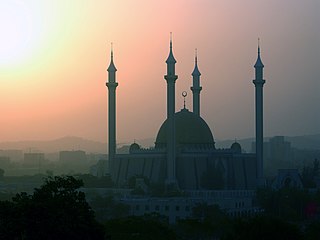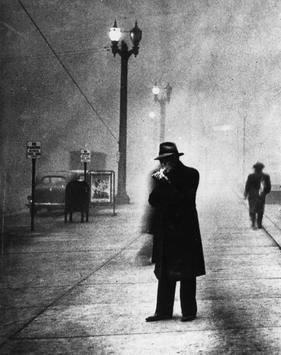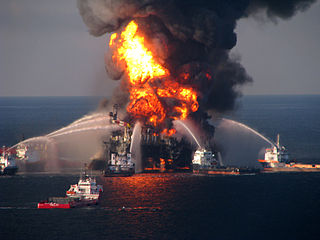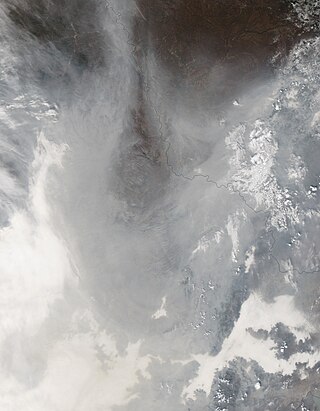
Pollution is the introduction of contaminants into the natural environment that cause adverse change. Pollution can take the form of any substance or energy. Pollutants, the components of pollution, can be either foreign substances/energies or naturally occurring contaminants.

Smog, or smoke fog, is a type of intense air pollution. The word "smog" was coined in the early 20th century, and is a portmanteau of the words smoke and fog to refer to smoky fog due to its opacity, and odor. The word was then intended to refer to what was sometimes known as pea soup fog, a familiar and serious problem in London from the 19th century to the mid-20th century, where it was commonly known as a London particular or London fog. This kind of visible air pollution is composed of nitrogen oxides, sulfur oxide, ozone, smoke and other particulates. Man-made smog is derived from coal combustion emissions, vehicular emissions, industrial emissions, forest and agricultural fires and photochemical reactions of these emissions.

Donora is a borough in Washington County, Pennsylvania, United States, approximately 20 miles (32 km) south of Pittsburgh along the Monongahela River. The population was 4,558 as of the 2020 census.

Engis is a municipality of Wallonia located in the province of Liège, Belgium.

The Great Smog of London, or Great Smog of 1952, was a severe air pollution event that affected London, England, in December 1952. A period of unusually cold weather, combined with an anticyclone and windless conditions, collected airborne pollutants—mostly arising from the use of coal—to form a thick layer of smog over the city. It lasted from Friday 5 December to Tuesday 9 December 1952, then dispersed quickly when the weather changed.

Haze is traditionally an atmospheric phenomenon in which dust, smoke, and other dry particulates suspended in air obscure visibility and the clarity of the sky. The World Meteorological Organization manual of codes includes a classification of particulates causing horizontal obscuration into categories of fog, ice fog, steam fog, mist, haze, smoke, volcanic ash, dust, sand, and snow. Sources for particles that cause haze include farming, traffic, industry, windy weather, volcanic activity and wildfires. Seen from afar and depending on the direction of view with respect to the Sun, haze may appear brownish or bluish, while mist tends to be bluish grey instead. Whereas haze often is considered a phenomenon occurring in dry air, mist formation is a phenomenon in saturated, humid air. However, haze particles may act as condensation nuclei that leads to the subsequent vapor condensation and formation of mist droplets; such forms of haze are known as "wet haze".

The Clean Air Act 1956 was an Act of the Parliament of the United Kingdom enacted principally in response to London's Great Smog of 1952. It was sponsored by the Ministry of Housing and Local Government in England and the Department of Health for Scotland, and was in effect until 1993.

The 1939 St. Louis smog was a severe smog episode that affected St. Louis, Missouri on November 28, 1939. Visibility was so limited that streetlights remained lit throughout the day and motorists needed their headlights to navigate city streets.
The 2006 Hajj stampedeor crush resulted in the deaths of 363 pilgrims on 12 January 2006 during the Hajj in Mecca. It took place on Jamaraat Bridge around 1pm on 12 January 2006, the fifth and final day of the Hajj. Between two and three million pilgrims attended the Hajj in 2006. Earlier, on 5 January at least 76 pilgrims died when a hostel collapsed in Mecca.

The 1948 Donora smog killed 20 people and caused respiratory problems for 6,000 of the 14,000 people living in Donora, Pennsylvania, a mill town on the Monongahela River 24 miles (39 km) southeast of Pittsburgh. The event is commemorated by the Donora Smog Museum.

Pea soup fog is a very thick and often yellowish, greenish or blackish fog caused by air pollution that contains soot particulates and the poisonous gas sulphur dioxide. This very thick smog occurs in cities and is derived from the smoke given off by the burning of soft coal for home heating and in industrial processes. Smog of this intensity is often lethal to vulnerable people such as the elderly, the very young (infants) and those with respiratory problems. The result of these phenomena was commonly known as a London particular or London fog; in a reversal of the idiom, "London particular" became the name for a thick pea and ham soup.

Energy resources bring with them great social and economic promise, providing financial growth for communities and energy services for local economies. However, the infrastructure which delivers energy services can break down in an energy accident, sometimes causing considerable damage. Energy fatalities can occur, and with many systems deaths will happen often, even when the systems are working as intended.

A dense wave of smog began in Northeast China, especially in major cities including Harbin, Changchun and Shenyang, as well as the surrounding Heilongjiang, Jilin, and Liaoning provinces on 20 October 2013. Unseasonably warm temperatures with very little wind across northeastern China coincided with the initiation of Northeast China's coal-powered municipal heating system. Record densities of fine particulates were measured in the city.

The 2013 Eastern China smog was a severe air pollution episode that affected East China, including all or parts of the municipalities of Shanghai and Tianjin, and the provinces of Hebei, Shandong, Jiangsu, Anhui, Henan, and Zhejiang, during December 2013. A lack of cold air flow, combined with slow-moving air masses carrying industrial emissions, collected airborne pollutants to form a thick layer of smog over the region. Levels of PM2.5 particulate matter averaged over 150 micrograms per cubic metre; in some areas, they were 300 to 500 micrograms per cubic metre.
Eli Kaj Roholm was a Danish scientist and researcher best known for his study of fluorine and fluoride toxicity.
An air pollution episode is an unusual combination of emissions and meteorology - usually low or stagnant winds and temperature inversion - that creates prolonged and widespread air pollution lasting two to seven days. Effects range from eye irritation to deaths across age groups. Examples of air pollution episodes include:

The following events occurred in December 1930:

The 1966 New York City smog was a major air-pollution episode and environmental disaster, coinciding with that year's Thanksgiving holiday weekend. Smog covered the city and its surrounding area from November 23 to 26, filling the city's air with damaging levels of several toxic pollutants. It was the third major smog in New York City, following events of similar scale in 1953 and 1963.
The 1962 London smog was a severe smog episode that affected London, England, in December 1962. It occurred ten years after the Great Smog of London, in which serious air pollution had killed as many as 12,000 people. While the 1952 smog had led to the passing of the 1956 Clean Air Act, which restricted the burning of domestic fuels in urban areas with the introduction of smokeless zones, fogs continued to be smoky in London for some years after the act as residents and operators were given time to convert from domestic fuels. The December 1962 smog is thought to have led to the deaths of up to 700 people.

The 2024 India–Pakistan smog is a severe record-breaking air pollution event that affected Eastern and Northern Pakistan and North India in November 2024, primarily in the Pakistani city of Lahore and Indian city of Delhi. The smog resulted in the overwhelming of the Pakistani healthcare system due to respiratory disease and throat and eye irritations, leading to widespread school closures and restrictions on public activities particularly in Pakistan's Punjab region.
















